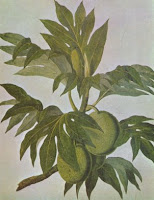 |
| Breadfruit |
At the Botanic Garden we have educational visits from all age ranges and all subjects. Primary school children come to learn about the very basics of plants, what they need to grow and what they do to survive; secondary schools come to learn about plants and what it is to run a business like this; sixth form art students can often be seen sitting around the Garden. The University brings a diverse selection of faculties to the Garden; the Biologists come and have complex tours based on evolution and adaptation; the School of Medicine will be using the Garden more in the future with the angle of plant’s role in medicine; the Philosophy students visit each year and have a tour before sitting next to a favoured plant and writing their thoughts.
This week we have a visit from the School of Geography who would like a tour in the context of plants and colonialism, so I’ve been doing some reading. This is a fascinating subject and laced with repercussions that we still feel today; the early Botanic Gardens have a lot to answer for. I’ve read about cotton which was one of the main industries that funded British colonialism, to sugar, rubber, quinine and tea which all were utilised from the plants of distant lands and usually involved great human tragedy. One of the most compelling stories is that of Captain Bligh and his ship The Bounty. The 229th anniversary of the famous mutiny is just around the corner, April 28th; so its worth retelling the tale.
Captain Bligh was under instructions from Sir Joseph Banks, a renowned botanist and plant hunter who took part in James Cook’s voyage to Australia and named Botany Bay. Banks had the idea that a cheap and nutritious food he had come across in Tahiti could be used to feed slaves working on the sugar plantations of the Caribbean. This plant was called the bread fruit (Artocarpus altilis) due to the high carbohydrate and fibre content; it is also easy to grow and high yielding. Bligh set off with over a thousand plants and headed for a colonial Botanic Garden on the Island of St Vincent. His crew mutinied, and he was set adrift on a lifeboat with 18 of his crew and little provisions before making an astounding 3,618-mile voyage to Timor and safety. His reward, another go at the breadfruit mission. In his second attempt he made it through storms and 27,000 miles to the Caribbean with over 600 of seedlings which were grown on in the Botanic Garden.
 |
| Captain Bligh |
In the end, the slaves on the plantations made a stand against being made to eat the bland breadfruit for every meal, so it was fed to pigs for the next 40 years. Today it is a staple of the Jamaican diet and is beginning to be viewed as a super food. The St Vincent Botanic Garden still exists, and the cruel echoes of slavery and colonialism are still reverberating in the 21stcentury.
Finding the stories in plants is one of the pleasures of working in a Botanic Garden, and being able to use plants to illustrate history, medicine, philosophy to students and young people is what we’re all about now; that and conserving rare and threatened species while communicating our rich and varied relationship with plants.
Andy Winfield
 |
| St Vincent Botanic Garden in 1825 |

